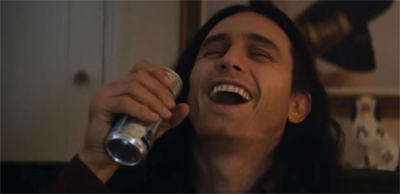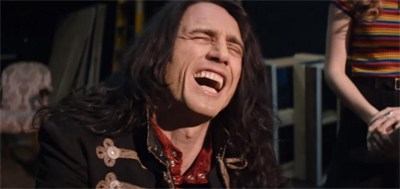The Disaster Artist opens by professing its love for its subject, the enigmatic Tommy Wiseau.
A variety of talking heads, primarily comedians, make a reasonable case for The Room as a beloved cult classic. The segment is short, but it sets the tone for a lot of what follows. The Disaster Artist doesn’t exactly obscure the (infamous) difficulties experienced during the production of that cult classic, mostly caused by the fragile ego and highly strung creative force behind the movie. However, there is also a sense that The Disaster Artist has an abiding affection for its subject, a sincere appreciation for the sheer force of Tommy Wiseau’s will.

Wiseau guy.
The Disaster Artist is ultimately a heartwarming tale about an outsider overcoming nearly impossible odds (which are not helped by the temperament of the outsider himself) to realise his dreams. Tommy Wiseau comes to Hollywood and decides to make something of himself, despite being told that he has no talent and no charisma, and that the best he could hope for would be to be cast as a “malevolent presence.” Wiseau proves all of his doubters wrong by shepherding his vision through a disastrous production cycle and releasing a cult classic.
It just so happens that Wiseau’s vision is absolutely terrible.

Edge of your seat stuff.
The Disaster Artist pulls some of its punches in order to tell the story that it wants to tell. The movie acknowledges the creepier side of Wiseau’s possessive relationship with Greg Sestero, the young actor who comes under his wing and whom Wiseau calls “baby face.” The film hints at the psychological tug of war between the two men during the production of their masterpiece, whether Wiseau’s obvious discomfort with Sestero’s girlfriend or an awkward power play involving a coveted guest spot on Malcolm in the Middle.
Indeed, there are some awkward sequences in the middle of the film that detail Wiseau’s legendarily awful behaviour on set. Wiseau was a nightmare to work with, as any of his collaborators will acknowledge. The Disaster Artist features any number of horrific stories in which Wiseau’s paranoia and impatience are taken out on the people around him. Whether it’s his erratic schedule or his refusal to pay for air conditioning and water, The Disaster Artist avoids romanticising the troubled production process itself.

Framing the story.
However, it is very clear that director and star James Franco has a great deal of affection for his subject. When the film inevitably reaches the premiere of The Room, the film makes a point to focus on Wiseau’s “written by”, “produced by” and “directed by” credits. The Disaster Artist clearly admires Wiseau’s ability to realise his vision without any inhibition or compromise. Repeatedly in the film, Wiseau appeals to the people around him to “just do it”, and there is a sense that everything in life is just that simple to Wiseau.
Just do it. It is a simple philosophy, but an appealing one. It is easy to understand why The Disaster Artist would fetishise Wiseau. The film makes a big deal of Wiseau’s enigmatic history, allowing itself to get sucked into the mythology that the actor cultivated around himself. He speaks with a vaguely Eastern European accent while claiming to be from “newowleans” and pays for the film from a “bottomless” bank account. “Don’t talk about me,” Wiseau admonishes Sestero early in the film, but The Disaster Artist understands the paradox at play here.

Drinking it all in.
The Disaster Artist understands the appeal of a figure like Wiseau, and it is easy to see why Sestero would have been swept up in Wiseau’s sheer and unrelenting energy. Wiseau is an individual with no gap between impulse and action, no filter between what he wants and what he does. That is an attribute that is as intoxicating as it is infuriating, and it is clear that Franco is just as captivated as Sestero was. Franco plays Wiseau as a fundamentally tragic, somebody who wants to create art without ever really understanding the people around him.
Everything about Wiseau is off. Sometimes in serious ways, and sometimes in small subtle shifts. Even the way that Wiseau drinks Red Bull looks uncanny, as if the actor and writer had to reverse engineer the concept of using his hands to drink from a can rather than picking the activity up through observation of other people. At one point in The Room, Wiseau is asked to react to a horrific story. He laughs. The characters try to figure why Wiseau would laugh at such a horrific tale. “People are crazy,” he offers by way of excuse. “Human behaviour.”

Open mike.
As anybody with any familiarity with The Room will attest, Wiseau seems to have learned about human behaviour through a weird game of whispers. He understands the vague concept of how people behave and what they want, but never the finer detail. The Disaster Artist suggests that many of the strange tics of The Room cannot be blamed on poor storytelling or structuring by Wiseau, but are instead a reflection of a more fundamental disconnect. Wiseau seems to have difficulty processing how people act and think, something that informs his own behaviour and writing.
The Disaster Artist belongs to a relatively recent subgenre of biopics that explore losers and misfits, characters who were by all accounts not good enough to make it but somehow did. The Disaster Artist is clearly of a piece with films like Florence Foster Jenkins and Eddie the Eagle, films about characters who refuse to let their complete lack of talent stand in the way of their artistic visions. These stories can be patronising and condescending, ignoring the care and craft that goes into doing something well, in favour of cheap sentimentalism about following a dream.

Acting, dear boy.
The Disaster Artist walks that line very carefully. There are certainly points where it looks like the film might trip over itself into cloying and unearned sentimentality. In particular, the movie’s final act feels a little bit neat, accelerating the ascent of The Room to cult classic in order to provide a clean end to this particular story. However, there is just enough darkness in the tale that The Disaster Artist retains its balance. Wiseau is an eccentric creative, but he is also a volatile egomaniac.
The Disaster Artist ultimately arrives to celebrate Wiseau, not to bury him. The film has a strange warmth to it, an abiding affection for the weird cult phenomenon that is The Room. More than that, the film reflects a deep appreciation for the communal love of movies. The Disaster Artist is not a film that loves cinema in the same way as Argo or La La Land. Instead, The Disaster Artist is a film that loves the way that people love film. It is a subtle distinction, but an important one.

A Stella performance.
The Disaster Artist is a movie that appreciates Wiseau’s sheer and unreserved commitment to the fakery involved in trying to “make real Hollywood movie”, the bizarro logic where it makes more sense to shoot on a facsimile of an alleyway than in an actual alleyway. However, The Disaster Artist‘s love of people who love movies extends even beyond Wiseau himself. This is a movie that understands that even bad movies can be loved, and that there is something positive and infectious about the fun that an audience can have with right type of bad movie.
The Disaster Artist is sincere and endearing in its affection for its subject, and the film makes the case that this is only appropriate given that subject’s own sincere and endearing affection for cinema itself. The Disaster Artist might have sanded some of its edges just a little bit too smooth, but it is still a joyful and infectious celebration of the art of a bad movie.
Filed under: Non-Review Reviews | Tagged: film, James Franco, Movie, non-review review, review, the disaster artist, the room, Tommy Wiseau |




















Had a great time with The Disaster Artist!
It’s great fun, isn’t it!
Oh hi Darren! 🙂
My girlfriend is fascinated with The Room, or maybe obsessed. She loves watching it, making fun of it for the atrociously incompetent and misogynistic train wreck that it is. She even dragged me to a theatrical showing a couple of years ago. That was actually a bit cathartic, since I got to vent my utter disdain for the movie and shout out insults at the screen along with the rest of the audience, as well as throw plastic spoons at the screen.
So of course my girlfriend very much wants to see The Disaster Artist. I’m relieved to hear from you that it’s a decently made piece.
“Wiseau is an individual with no gap between impulse and action, no filter between what he wants and what he does.”
So basically Tommy Wiseau is a poor man’s Donald Trump?
Ha!
That’s probably fair, although it should be noted that Wiseau actually accomplished a lot of what he set out to do.
You tear me apart, Darren.
Great review btw
Thanks!
Ha!
You make real American comment, Jorge.
A really good review! I agree, you could tell that James Franco had a lot of passion for this project. I think that’s part of why it turned out so well. If you have a chance, would you mind checking out my review of The Disaster Artist? Thank you! https://ticketsandpopcorn.wordpress.com/2017/12/03/the-disaster-artist-2017/
Thanks Catherine!